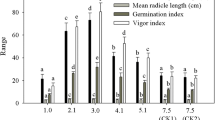Abstract
This research aimed to determine whether low moisture content storage improves the longevity and storability of Zygophyllum xanthoxylon (Bge.) Maxim seeds. The seeds of Z. xanthoxylon were dried from 11.43 to 4.81%, 3.81 and 2.41% moisture content in a desiccating container with silica gel. After storage for 24 months their level of vigor was measured. After the ageing process, some physiology indices, including the relative electrical conductivity, SOD, PER, CAT, volatile aldehydes and malondialdehyde were tested. The results indicated that SOD, PER and CAT activities of the low moisture content seeds were higher than the control seeds while volatile aldehydes and malondialdehyde were lower than the control group. The electrical conductivity showed that there was obvious statistical difference between low moisture content seeds with the control group. All the results showed that low moisture content storage is beneficial for maintaining the vigor of Z. xanthoxylon seeds. Thus Z. xanthoxylon seeds can be stored with low moisture content at ambient temperature condition for a long time.



Similar content being viewed by others
References
Bailly C, Benamar A, Corbineau F (1996) Changes in malondialdehyde content and in superoxide dismutase, catalase and glutathione reductase actibities in sunflower seeds as related to deterioration during accelerated aging. Physiol Plant 97:104–110
Bowler C, Montagu M, Inze D (1992) Superoxide dismutase and stress tolerance. Annu Rev Plant Physiol Plant Mol Biol 43:83–116
Christina W, Eric E, Steve A (1996) An analysis of seed storage practices. In: Gass T et al (eds) Challenges in rye germplasm conservation. International Plant Genetic Resources Institute, Rome, pp 15–31
Ellis RH, Hong TD, Roberts EH (1990a) Low-moisture-content limits to relations between seed longevity and moisture. Ann Bot 65:493–504
Ellis RH, Hong TD, Roberts EH (1990b) Effect of moisture content and method of rehydration on the susceptibility of pea seeds to imbibition damage. Seed Sci Technol 18:131–137
Ellis RH, Hong TD, Roberts EH (1995) Survival and vigour of lettuce (Lactuca sativa L.) and sunflower (Helianthus anuus L.) seeds stored at low and very low moisture contents. Ann Bot 76:521–534
FAO/IPGRI (1994) Genebank standards. Food and agriculture organization of the United Nations. International Plant Genetic Resources Institute, Rome
Giannoplitis CN, Ries SK (1977) Superoxide dismutase purification and quantitative relationship with water-soluble protein in seedlings. Plant Physiol 59:315–318
Goel A, Sheoran IS (2003) Lipid peroxidation and peroxide-scavenging enzyme in cotton seeds under natural ageing. Biol Plant 46:429–434
Huang ZY, Zhang XS, Zheng GH (2002) Increased storability of Haloxylon ammodendrom seeds in ultradry storage. Acta Bot Sin 44(2):239–241
ISTA (1999) International Seed Testing Association. International rules for seed testing. Seed Sci Technol 27:27–35, 47–50
Kalpana R, Madhava, Rao KV (1995) On the aging mechanism in pigeonpea (Cajanus cajan L.) seed. Seed Sci Technol 23:1–9
Li Y, Feng HY, Chen T (2007) Physiological responses of Limonium aureum seeds to ultra-drying. J Integr Plant Biol 49:569–575
McDonald MB (1999) Seed deterioration: physiology, repair and assessment. Seed Sci Technol 27:177–237
Narayana Murthy UM, Prakash P Kumar, Wendell QS (2003) Mechanisms of seed ageing under different storage conditions for Vigna radiate (L.) Wilczke: lipid peroxidation, sugar hydrolysis, Maillard reactions and their relationship to glass state transition. J Exp Bot 54:1057–1067
Noctor G, Foyer CH (1998) Ascorbate and glutathione: Keeping active oxygen under control. Annu Rev Plant Physiol Plant Mol Biol 49:13–37
Pinhero RG, Paliyath G, Yada RY (1998) Modulation of phospholipase D and lipoxygenase activities during chilling: relation to chilling tolerance of maize seedlings. Plant Physiol Biochem 36:213–224
Powell AA, Matthews S (1978) The damaging effect of water on dry pea embryos during imbibition. J Exp Bot 29:1215–1229
Sun WQ, Leopold AC (1997) Cytoplasmic vitrification and survival of anhydrobiotic organisms. Comp Biochem Physiol 117A:327–333
Vertucci CW, Roos EE, Crane J (1994) Theoretical basis of protocols for seed storage III. Optimum moisture contents for pea seeds stored at different temperatures. Ann Bot 74:531–540
Wang XF, Zheng GH, Yang SJ (1999) Effect of ultradry storage on fluidity of plasma membrane of seeds. Chin Sci Bull 44:1008–1013
Wang XF, Jing XM, Lin J (2003) Studies on membrane function and sugar components of ultradried seeds. Acta Bot Sin 45:23–31
Wilson D, Mcdonald M (1986) A convenient volatile aldehydes assay for measuring soybean seed vigor. Seed Sci Technol 1:256–258
Zhao YZ, Zhu ZY (2003) The endemic genera of desert region in the centre of Asia. Acta Bot Yunnanic 25(2):113–121 (in Chinese)
Zheng GH, Jing XM, Tao KL (1998a) Ultradry seed storage cuts cost of gene bank. Nature 393:223–224
Zheng GH, Yan YT, Zhang QC (1988b) Studies on the imbibitional chilling injure and the reparation of damaged membrane systems in soybean seeds. Sci Sin 31(6):45–53
Zhou XR, Zhou ZY, Wu CX (2006) The Research of the breeding characters of Zygophyllum xanthoxylum. Pratacultural Sci 23(6):38–41 (in Chinese)
Zhu C, Zeng GW, Hu JS (2001) Aging-resistance of ultra-dried onion seeds and its free radical scavenging. J Zhejiang Univ (Agric Life Sci) 27(2):139–144
Acknowledgments
This research was supported by National Natural Science Foundation of China (90302010). The authors wish to thank anonymous referees for suggestive comments and modification.
Author information
Authors and Affiliations
Corresponding author
Additional information
Communicated by S. Weidner.
Rights and permissions
About this article
Cite this article
Li, Y., Qu, J., Dong, Z. et al. Storage behavior of Zygophyllum xanthoxylon (Bge.) Maxim seeds at low moisture contents. Acta Physiol Plant 30, 651–656 (2008). https://doi.org/10.1007/s11738-008-0161-7
Received:
Revised:
Accepted:
Published:
Issue Date:
DOI: https://doi.org/10.1007/s11738-008-0161-7




